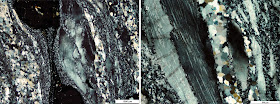Certain types of rocks develop due to deformation and shearing that happen frequently along the fault zones. Extreme pressure and strain are responsible for recrystallization of rocks. Tiny grains of newly formed minerals develop along the boarders of the preexisting minerals. This texture called porphyroclastic.
The processes of shearing are very dynamic. The friction along the fault zones might cause significant rise of temperature. The rocks located in these zones experience brittle deformation, grinding and sometimes even melting, that occurs along the most intensive friction. Rapid solidification of the melt creates glass. The formed glassy rock is called psudotachylite, which was named after resembling tachylite (natural basic glass).
This rocks came from Australia. Courtesy of Dr. Alfredo Camacho.
Mylonite:
 |
| Mylonite hand-specimen. Grey veins - quartz, pink ones - orthoclase. Red grains and groups of grains - garnet. |
 |
| Veins of psudotachylite and fragments of fractured rocks in biotite-garnet gneiss |
 |
| The fragments of host rock cemented with newly formed (in-situ) glass. PPL |
 |
| The vein of psudotachylite. Note the chilled margin, bottom left corner. PPL. |


